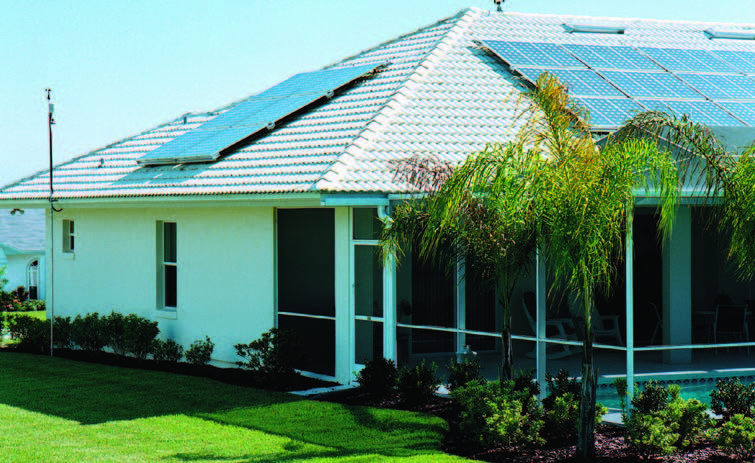Recent decisions by Florida’s utility regulation commission mean that the state is leaving key energy resources on the cutting room floor. Here’s why the Sunshine State is way in the dark on this one.
The Florida Public Service Commission, charged with keeping the lights on at an affordable cost, has just decided to dramatically cut—even “gut”—how much the state’s major utilities will be investing in energy efficiency, at the urging of those same utilities. The Southern Alliance for Clean Energy and Earth Justice say that the cuts are “historic” (and they don’t mean that as a compliment):
The goals approved by the Commission are stunning rollbacks compared to the goals set by the PSC in 2009, ranging from an 87%–99% reduction in customer energy savings.
It’s about bills, not rates

The Sunshine State isn’t so hot when it comes to making use of its own energy resources.
The PSC, for its part, says that the combination of decisions will “keep customer rates in check.”
Of course, when people think about what electricity is costing them each month, they’re not thinking about per-kilowatt-hour rates, but about what it adds up to when it comes time to pay (rates times amount).
And, it turns out, Florida ranks poorly on that account: while Florida has lower electric rates than many other states (its rates are the 16th cheapest), it’s way down (43rd cheapest) on electricity bills.
You could chalk up that poor performance on electric bills to high air-conditioning usage in a sun-drenched state. Or you could realize that air-conditioning is just one more area where incredible advances in technology in recent years mean that you can do so much more with so much less… when your state and utility are onboard with helping you save.
How Florida stacks up on energy efficiency
So where are Florida and its utilities on that count? Way down the list there, too. The 2014 state energy efficiency rankings from the American Council for an Energy-Efficient Economy (ACEEE) have Florida at #28.
A big piece of the state’s poor energy efficiency showing is its electric sector action, or non-action: Florida scores a 1.5 out of 10 possible points for electric efficiency program budgets and savings. The state’s electric efficiency program budgets, at 1.13% of statewide utility revenues, are way below not just the leaders of the EE pack by this measure—Rhode Island (8.55%) and Massachusetts (6.42%)—but also Arizona, Arkansas, Nevada, and many others.
And Florida’s grades are way low in other areas, too, say ACEEE:
- Florida gets only 0.5 out of 5 for its incremental electricity savings—0.27% of retail sales per year, vs. above 2.0% for the leaders.
- It scores a 1 out of 5 on effectiveness in promoting combined heat and power (CHP) systems; leaders score 4.5.
- It gets 0 out of 2 for state-level appliance standards, meaning it’s not even trying to go beyond federal standards, unlike other states.
Only in building codes does Florida make it out of “F” territory (6 out of 7).
Lots of areas for improvement.

Let the sunshine in.
And the Florida PSC didn’t just leave behind energy efficiency. They also approved phasing out rebates for rooftop solar, the kind that have been so important in fomenting a solar revolution in recent years. So the Sunshine State, already ranked way down at 12th in the country for installed solar, seems likely to now fall farther behind the likes of New Jersey, Massachusetts, and North Carolina.
The future of clean energy, even if Florida doesn’t see it
The good news? If there’s any silver lining, it was that Florida’s recent policy decision was a squeaker. Two of the five commissioners said no to the evisceration plan: Commissioner Lisa Edgar (just elected president of NARUC, the national organization of utility regulators) and Commissioner Julie Brown, who said, of energy efficiency, “I think we should be investing in all of it.”
There are lots of reasons to think Commissioner Brown is right. Energy efficiency continues to be the cheapest option, even in states that have picked a whole lot more of the low-hanging fruit than Florida has.

Energy efficiency is generally the cheapest—and least risky—option around. (Source: Ceres)
In fact, in commenting on the draft EPA plan for addressing carbon from power plants, UCS pointed out, as did many others, that energy efficiency could actually be playing a much larger role than the EPA had proposed.
The powerful economics of energy efficiency and solar energy mean this fight isn’t over. And experience suggests that people all across the political spectrum understand the importance of clean energy for making them more secure, more comfortable, and better off.
In the meantime, keep an eye on your state’s public service commission. They can play a really important role in moving us toward a better energy future. But, as Florida’s experience shows, it doesn’t always work out that way.
